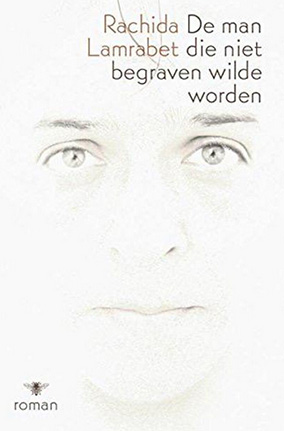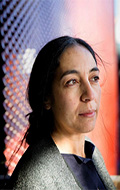Diversity within the diversity
Rachida Lamrabet
When it comes to Dutch Literature in Translation, a lot of the attention is naturally (and deservedly) given to huge names who paved the way in a target country, who have shaped the image of Dutchness and Dutch literature in the world, and who have had undeniable success in their reception. In a way, what is Dutch is already ‘diverse’ to, for example, an Italian reader, and that is true for authors as well, whether they’re Dutch-born (Cees Nooteboom, Willem Frederik Hermans, Jan Brokken, Frank Westerman), born in the former colonies (Hella S. Haasse) or naturalised, such as Kader Abdolah, one of the most beloved and translated authors writing in the Dutch language. Such names may sound familiar to most readers, they are deeply diverse in their style and topics and each has earned world-wide fame. But except for Haasse, the ‘great dame’ of the Dutch letters, they are also all men, and Dutch-Dutch: nederlanders. But Dutch — het Nederlands — is not exclusively what is about or has to do with the Netherlands as a country: there’s Flemish too, a variant of Dutch, one could say, spoken in Belgium, precisely in Flanders.
The use of two different words in English makes a greater distinction which might sometimes create confusion, but the language is the same: to an Italian speaker, for example, ‘olandese’ directly refers to Holland, to the Netherlands, but ‘neerlandese’ (or ‘nederlandese’) would be the correct term, language-wise, because it includes the Flemish variant too (‘fiammingo’, het Vlaams). Small, but crucial distinctions which a bit too often get (literally) lost in translation. That is why it is important to remember that Flemish literature is literature in the Dutch language, and Dutch literature in translation owes a lot to Flemish writers too — think of Stefan Hertmans’ War and Turpentine, Tom Lanoye, Louis Paul Boon, Annelies Verbeke. The landscape gets richer and more varied on both sides and the list could go on, if we were to name authors both classic and contemporary, poets, writers of children books, post-colonial fiction, non-fiction… and most of them have not been translated in many languages (yet!). The message here is that ‘Dutch’ is not just one thing, and that diversity is almost a given in these cases: diversity in time, in genres and in gender, diversity in style and language usage, diversity within the same language, diversity within the same country. All of which brings me to a contemporary author I had the chance (and pleasure) to read and translate for my master’s thesis and, sometime later, to meet: Rachida Lamrabet.
Lamrabet’s name came up when discussing options with my professor, who suggested I read the paper of a colleague who’d researched what is generally known as migratieliteratuur, migrant literature. In her PhD thesis, Annaclaudia Giordano focused on two prominent female writers in the Dutch language: the late Moroccan-Dutch author Naima El Bezaz, and Moroccan-born Belgian author Rachida Lamrabet. Giordano contributed greatly to Dutch studies in Italy on this topic, as she integrated their biographies and analysed their works and key themes, underlining how oftentimes women writers get overshadowed by — and are less researched and less translated than — their male counterparts.
Rachida Lamrabet - from jurist to writer

Rachida Lamrabet was born in Morocco and moved with her mother and brother to Belgium when she was two years old, so that they could reunite with her father, as he had already moved North as one of the many gastarbeiders (guest workers) of the 60s and 70s — men who left their mother countries to go and work abroad in order to make some money and help their families back home. Despite growing up in a Flemish environment and speaking the Flemish language, Lamrabet was exposed soon enough to the idea of diversity because of the discrimination she experienced, both in Belgian cities and later in her life at school and university, so much so that against all odds she chose to follow her passions through, graduated in Law and went on to become a jurist.
Aside from her work in the legal field, which saw her engaged in different projects focusing on equal opportunities, diversity and laws against discrimination, she also turned to writing in 2006, when she published a short story in a collective work promoting the newer voices of contemporary Flemish fiction, local or foreign — or like in her case, second-generation writers (that is, children of the second generation of migrant workers). Her debut came the year after with Vrouwland (Womanland), a novel in which the three protagonists deal with what being diverse in the modern multicultural society means, through stereotypes and contradictions. The topic of diversity and discrimination is further explored by Lamrabet in her following work, Een Kind van God (A Child of God), a series of short stories in which the characters are different people from different countries, all having trouble finding their place in contemporary Belgian society — such themes are central to most of Lamrabet’s work, which in the years had taken various forms too: De handed van Fatma (The hands of Fatima, theatre screenplay), Zwijg, allochtoon! (Silent, immigrant! non-fiction) and her latest novel, Vertel het iemand (Tell someone).
De man die niet begraven wilde worden

The other main novel highlighted here is the one I had the chance of working on in my training as a translator: De man die niet begraven wilde worden (The man who did not want to be buried). Published in 2011, the book follows Moncif, a middle-aged man living in Belgium and dealing with a personal crisis. The central theme in this striking novel is identity, as well as faith, being diverse, being discriminated and feeling stuck between two worlds in apparent contrast with each other: something Lamrabet herself has experienced in her life. At the beginning of the story, our main character is hidden in a morgue risking his life in a reckless plan, which will eventually be followed through and lead to the second half of the novel. It’s in this first part (which I decided to focus on), however, that Lamrabet’s style as a writer is fully developed: the stream-of-consciousness-like writing gives her the chance to transport the reader in her protagonist’s mind and body, while constructing her plot in a smooth alternation of action and flashbacks. This allows her to build her character with empathy and portray his internal struggle — with his own identity, his choices, his relationships — in a great example of introspection, as well as make use of the Dutch language’s potential in the descriptive passages, where motion verbs are most productive, all the while using her own knowledge of the Belgian-Dutch reality and her Moroccan heritage.
Alienation through diversity


References to places and concepts ‘typically Dutch’ (bruine kroegen is a perfect example) or to the Arabic world (religious terminology, greetings, traditions) often come up and are a core element of the novel for various reasons: first, they help reproducing the dichotomy between the societies, strengthening the concept of identity crisis as felt by the main character; second, they are interesting from a research-translation point of view as they can be translated, but the choice is never that simple; third, and most important here, because the Arabic elements specifically help to create a diversity factor which is felt, in this particular case, by the Dutch reader in the first place. When I had the chance to interview Mrs. Lamrabet and ask her some questions about style and word choice, I asked her why and how important using such cultural images and elements was for her, and she told me it was her goal to have an element of diversity, of strangeness in her book: the Dutch (or Belgian) reader would find Arabic terms and references without the necessary context, translation or explanation and feel vervreemd — alienated, estranged, diverse. This was most interesting and perfectly sums up Rachida Lamrabet’s oeuvre: her characters, such as herself, are people who are unfortunately used to being left out of the conversation, who struggle to fit in, whereas in this case it’s the readers who have to make the extra effort and get out of their comfort zone — a reminder that words are a powerful tool in every language they’re spoken in, and respecting that is essential, especially in translation. And similar words were spoken about a year ago, during the 16th meeting of the MediterraNed platform in Trieste in May 2022, where Rachida Lamrabet was introduced to the Italian public thanks to Annaclaudia Giordano’s Italian translation of Een Kind van God (Un figlio di Dio), together with the discussions on translation strategies that ensued at a roundtable during the academic conference.
A lot more could be said in detail on both Lamrabet — as woman and as writer — and translation strategies, but this is meant to be an introduction to diversity in contemporary Dutch literature, as well as an invitation to read (and translate) more authors like Rachida Lamrabet. To sum it up, what both Giordano argued in her PhD defence and what I concluded following her lead was this: more research projects and translations should focus on female writers, as more attention and relevance should be given to the Flemish landscape, where Brussels alone is but the tip of the ‘diversity iceberg’, being home to countless expats from all over the world, and consequently to their stories and experiences. Countless voices which need translation, and translators: Lamrabet’s case is a perfect reminder of the importance of teaching literature, of focusing on contemporary authors of both autobiographical and fictional stories, and consequently, of the importance of literary translation, because diversity is essential to cultural transfer, and the Netherlands and Flanders are full thereof.
(Axel Fabrizio Zanella)
